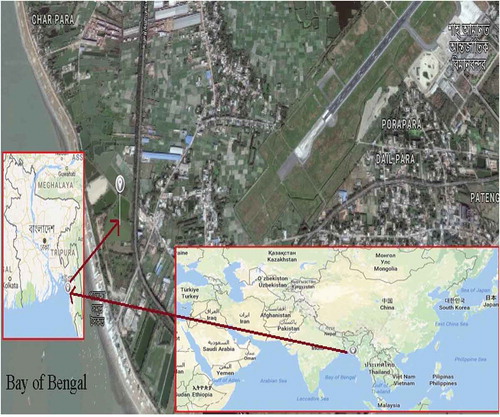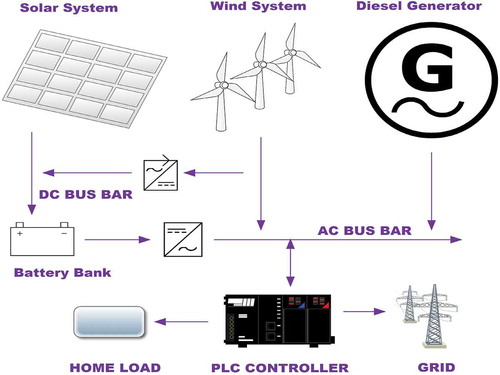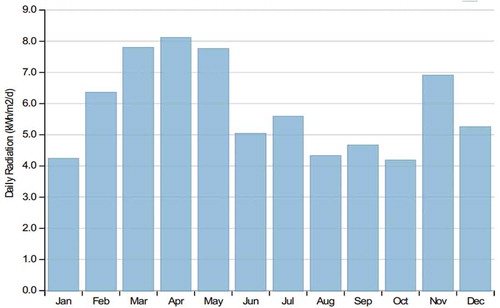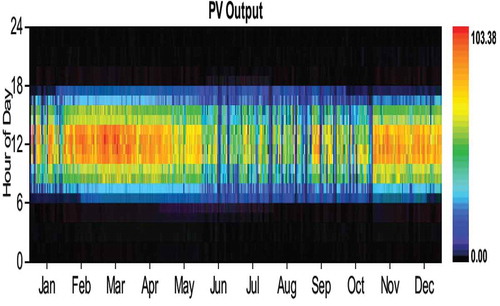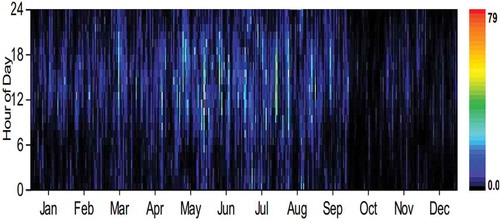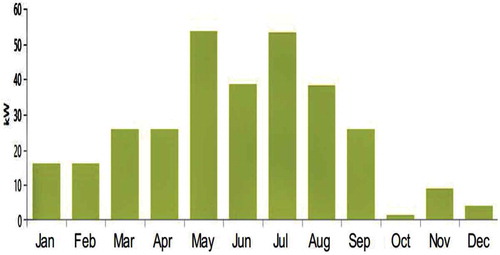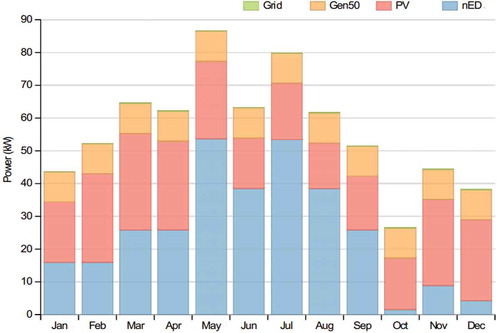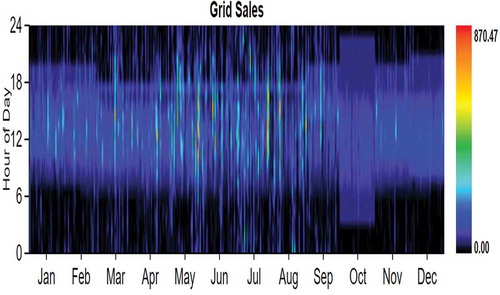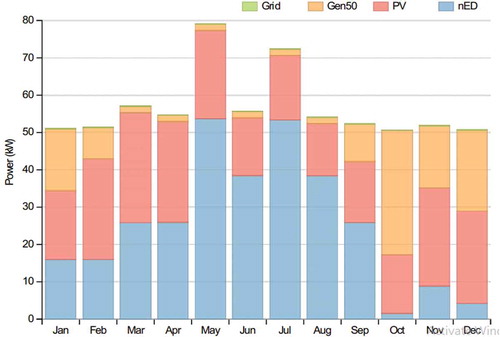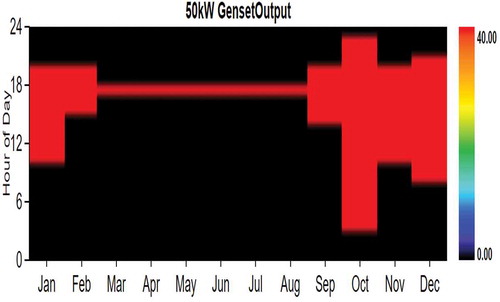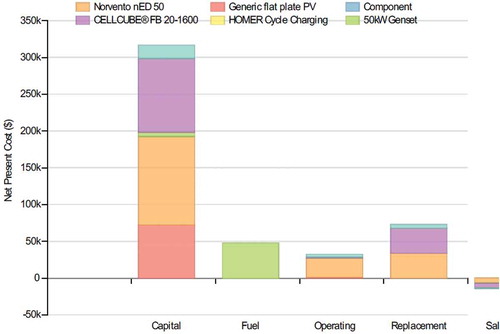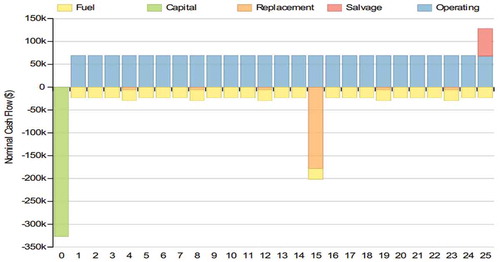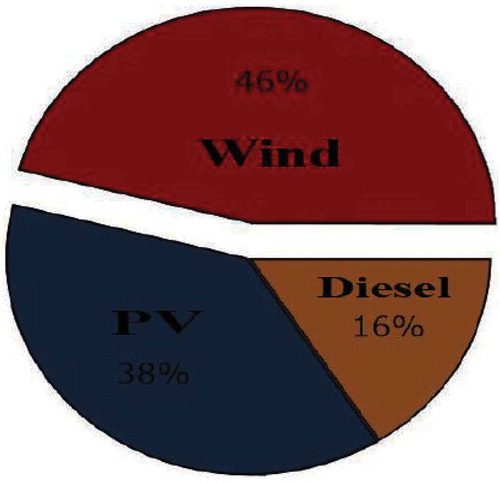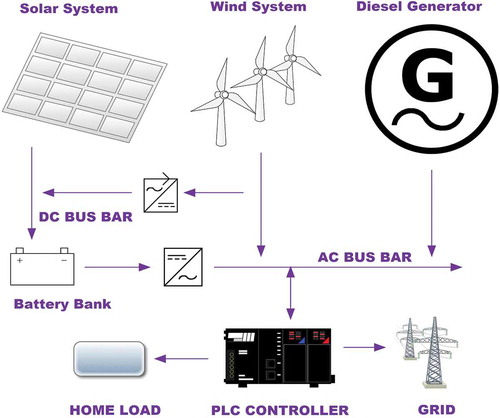Abstract
A quickly growing nation like Bangladesh is experiencing scarcity of efficient electricity production system. Upgrade of the electricity production system is required to keep the progress of the nation uninterrupted. Keeping this motto into consideration, in this research, a grid-connected hybrid system model has been identified to overcome the shortage of electricity in Bangladesh with the combination of photovoltaic, wind turbines, diesel generator for remote and upgrade areas. Photovoltaic and wind turbines are used as a main primary source and the diesel generator is kept as a standby source to fulfil our target. The proposed system is mainly the renewable energy-based plant because it is environmentally friendly with less emission carbon as well as other greenhouse gases, as well as the system is controlled by the programmable logic controller for supplying constant electricity. For design, optimization and grid connection, Patenga beach, Chittagong, Bangladesh has selected where resources are generally usable. Finally, it has been found that the cost of electricity scheme becomes as low as $0.12/kWh compared to the quick rental plant (around $0.33/kWh) in Bangladesh.
PUBLIC INTEREST STATEMENT
Referable to the shortage of conventional fuels, the rising quantity of fuel costs and environmental danger from fossil fuels, the conventional power generation is becoming unsustainable at this moment. Therefore, renewable energy such as sun, wind, geothermal, ocean, and biomass-based power generation is the best selection for Alternative power generation in the world-wide due to environmental matters and cost-effectiveness. On the other hand, Energy managements are the major concern for proper effectiveness. Control units are of the major elements of these journeys for the sustainable system. The main objective of this research is a cost-effective grid-connected hybrid power system which is proposed to meet the national electricity demand in Bangladesh, as well as a control system is optimized for supplying continuous power.
1. Introduction
Since the beginning of the twenty-first century, energy demand is rapidly increasing which is estimated to increase by 56% from 2010 to 2040. Even though, the nuclear power plants being capable of yielding a huge amount of power. However, due to the dangers associated with this plant makes electricity production risky. More than half of the power plants in Bangladesh which is estimated about are natural gas-based (Kabir et al., Citation2016). Current overuse will exhaust the natural gas within 6–7 years if we fail to discover any new natural gas field (Kabir et al., Citation2015). Under this severe circumstance, the Bangladesh Government is planning for various measures to meet the challenge. The oil-based quick rental project is one of the outcomes of such measures. Per-unit cost of this project is huge and it is about 26 BDT (Kabir et al., Citation2018). It creates a lot of bad effects on the economy and environment in Bangladesh. Currently, our generation is about 9500 MW (Bangladesh Power Development Board [BPDB], Citation2018). In 2030, the electricity demand will be 34,000 MW (Kabir, Matin, Amin et al., Citation2017). Bangladesh cannot sustain a quick rental power plant project for a long time. So, it has become inevitable for us to create a different scope of producing electricity to fulfil the demand. For instance, the government has taken to establish various power plants which are non-renewable; such as oil, gas, coal-based plants, and many more. In addition, the government has taken steps to establish a 1000 MW nuclear power plant at Ruppur. However, nuclear power needs a huge technological safety. If any kinds of disaster happen, it is very difficult for a country like Bangladesh to handle it because of lack of technical ability. Government has taken steps to establish 1320 MW thermal coal-fired plant in Rampal and 1200 MW plant in Moheshkhali; also, 1200 MW plant in Baskhali (Kabir & Matin Bhuiyan, Citation2017). It is also harmful to our nature. For this reason, to ensure energy security without any environmental impacts, it is important to create unconventional energy sources. Due to the shortage of fossil fuels and the limitations of using natural gas, Bangladesh has a vast potential for renewable energy because 72% are rural areas (Baky et al., Citation2017). A huge amount of sunlight during the day is a great blessing for Bangladesh as it contributes to a yearly average of about 4.5 kWh/m2/day (Billah et al., Citation2017).
In Patenga, annual average solar radiation is 4.63 kWh/m2/day, and annual average wind speed is 3.10 m/s (Bangladesh Meteorological Department, Citation2016; NASA surface meteorology and solar energy, Citation2018). Therefore, the hybrid system is one of the best choices to provide continuous power demand. Grid-Connected hybrid system with photovoltaic, wind, battery, and diesel generator seems to be most suitable and efficient. This proposed hybrid model ensures improved efficiency which consequently reduces per-unit cost of energy production. For design and optimization, Patenga, Chittagong has chosen because solar radiation is reasonable as well as the availability of wind speed. The main target of the system is to produce the electricity of 50 kW per hour every day. Thus, the projected demand is 1.2 MW/days which will elaborately discuss in section 4.
2. Energy sources and data analysis
Solar panels convert light energy into electrical energy. Sun radiation is absorbed with the panel materials and electrons that are emitted from the atoms that they are bounded. This released current creates solar power and converted into electrical power by the solar cell (Chowdhury et al., Citation2012). When PV cells are joined physically and electrically, it is called a solar panel or PV module. Panels join together and form a solar array. The sunlight impinging on panels, i.e. irradiance or isolation (incoming solar radiation), is measured in units of watts per square meter (W/m2). Generally, only 40% of sunlight radiation can be used by PV module (Bala & Siddique, Citation2009). The PV system gives the output as a direct current power. Wind power involves converting wind energy into electricity by using wind turbines. It converts kinetic energy into mechanical energy (Sebzali et al., Citation2013). A wind turbine is composed of a number of propeller-like blades called a rotor. The wind comes from the change of the air that moves around the surface of the earth. The power output of a turbine is a function of the cube of the wind speed. If wind speed increases, output power also increases. It can convert only 59% wind energy into electricity according to the Betz limit (Mathew, Citation2006). The Nonrenewable source diesel generator which operates at a low load is inefficient and fuel cost low, diesel generator consumes 30% of full-load fuel consumption (Shaahid & Elhadidy, Citation2005). The autonomous diesel generator has high operation cost, constant maintenance, and the transportation of fuel to remote locations is difficult and costly, mainly in the rainy season in Bangladesh (Zubair et al., Citation2012). Diesel generator uses to help fulfil the target demand. To analysis the price of diesel, this can vary considerably based on region, transportation costs, and current market price. In Bangladesh, the Diesel price of diesel is 0.7 USD/L, with the lower heating value of 42.3 MJ/kg, an emission density of 820 kg/m3, a sulphur content of 0.33%, and carbon content of 88%.
2.1. Resources data analysis
Chittagong is the commercial capital of Bangladesh. There are 20 Thana and Upazilla in Chittagong (Bangladesh National Portal, Citation2018). Patenga Thana in Chittagong city is the chosen area for the collection of resources data for software simulations. Patenga is located at 22 degrees 14.73 minutes North latitude and 91 degrees 47.24 minutes East longitude. One-year climate data and wind data are collected from Bangladesh Meteorological Department, Patenga airport branch and the average real-time solar radiation is 5.85 kWh/m2/day also collected one-year solar radiation data from NASA and average solar radiation is 4.76 kWh/m2/day (Bangladesh Meteorological Department, Citation2016; NASA surface meteorology and solar energy, Citation2018). The highest solar radiation is in April and the lower radiation is in October and the average clearness index is 0.51. Table shows the resources data for Patenga, Chittagong, Bangladesh.
Table 1. Global horizontal irradiance (GHI) data and wind speed for Patenga, Chittagong
3. Proposed hybrid system
A hybrid energy system has been proposed and thus have used two renewable energy (solar and wind) and a conventional energy diesel. When solar radiation falls on the PV cell, it will produce Direct current. After that, we used DC to DC regulator for the requirement of battery charging and the process will be controlled by the DC controller then store the PV power in the battery. Furthermore, an inverter to convert DC power into AC power. When wind flows rotates the wind turbine, it will produce AC Current. If the wind turbines produce less than 50 kW power, the power will go to the AC bar. If Wind turbine produces greater than 50 kW, the extra power will go to AC to DC converter then storage system battery. The combined power will supply the electrical load and national grid. If the primary combined power resources do not fulfil the targeted demand, then a diesel generator would be used as standby power to fulfil the targeted demand. The system controlled by a programmable logic controller. In addition, HOMER is used to optimize the most cost-effective configurations among a set of the hybrid system for electricity and MicroWin use for PLC Simulation (MicroWin Software, Citation2016).
The main target of the grid-connected hybrid system is to produce 1.2 MW/day. Therefore, the average electrical power is 50 kW/h and the project lifetime is 25 years. Table presents the proposed hybrid system component specification. Figures and represent the hybrid system model and geographical location which is situated at 22 degrees 14.73 minutes North latitude and 91 degrees 47.24 minutes East longitude at Patenga besides the Shah Amanat International Airport and Bay of Bengal, Chittagong, Bangladesh.
Table 2. Proposed system components specification
4. Simulation and results
To optimize and cost analysis of the system used HOMER Pro software. Entering all the data of solar radiation, wind speed and load based on HOMER software requirement for optimized the system (HOMER Energy, Citation2018; Kabir, Matin, Chowdhury et al., Citation2017).
4.1. System component specifications for simulation
The proposed solar panel capacity is (200 Wp × 500) = 100 kW. The wind turbine capacity is (10 kW × 8) = 80 kW, and alternate source diesel generator capacity is 50 kW. The battery capacity is 1600 kWh. There, source data are collected from Bangladesh Meteorological Department Patenga airport branch in January to December 2015. Figure shows the real-time solar radiation curve by HOMER and Table Shows the PV system specification.
Table 3. PV system specification
Figure represents the real-time wind speed curve by HOMER and Table shows the wind system specification. Table provides the diesel energy specification, and Table presents the battery specification of the system.
Table 4. Wind turbine generator specification
Table 5. Diesel generator specification
Table 6. Battery specification
The aimed of the system is to produce the electricity of 50 kW per hour on 365 days, but here it is shown only a household load demand collected from energy monthly bill. The uses of the household are tube light, energy bulbs, fans, laptop, TV, refrigerator, water pump, mobile charger, microwave, and many more.
2 km grid extension will be needed for the system to connect the National Grid. The rated capacity of grid purchase is 100 kW and the selling capacity is 1000 kW and the electricity price is 0.14 USD/kWh. Table provides the monthly load demand in a household. Table represents the grid connection and other system components specification.
Table 7. Monthly energy load demand
Table 8. Other components capacity and cost specification
4.2. Simulation results
The simulation results are discussed in the following subsection.
4.2.1. Photovoltaic energy analysis
The rated capacity of the PV panel is 100 kW and total electricity production is 186,035 kWh/yr. The mean output of the PV system is 21 kW.
Total hours of operation of the PV system are 4372 h/yr and per-unit cost of the PV system is 0.041$/kWh. Table represents the PV system output power also Figures and show the PV system daily and monthly electricity Production.
Table 9. PVsystem output power
4.2.2. Wind energy analysis
The rated capacity of the wind turbine generator is 80 kW; total electricity production is 225807 kWh/yr. The mean output of wind power is 26 kW.
Total hours of operation of the wind system are 5758 h/yr and per unit cost of the wind system is 0.059 $/kWh. Table presents the wind turbine output power also Figures and show the wind turbine daily and monthly electricity production.
Table 10. Wind turbine generator output power
4.2.3. Diesel energy analysis
The rated capacity of the diesel generator is 50 kW. The total electricity production of the diesel generator is 85,480 kWh/yr.
Total hours of operation of the diesel system are 2137 h/yr. Total fuel consumption is 26,862 L/yr. Table represents the Generator output power also Figure shows the generator yearly output curve.
Table 11. Diesel generator output power
4.2.4. Load and grid analysis
The main purpose of this work is to meet the national power demand. The aimed of the system is to contribute 1200 kW/day. The annual contribution is 438000 kWh/yr. The following results of the hybrid system are obtained in Table .
Table 12. Total hybrid electricity production and consumption
In this system, the production of electricity is 497323 kWh/yr. Figure shows total hybrid electricity production of the system. The system connected to the National grid for commercial purpose. The energy sell price is 0.149 USD/kWh. The annual grid sold 478,498 kWh/yr and the energy sold price is 71,725 USD/yr. Table shows an analysis of grid selling price and Figure represents the curve of energy sell into the grid.
Table 13. Analysis of grid selling price
5. Hybrid control system
The main target is to supply 50 kW electricity per hour, but Homer does not show the curve constantly 50 kW per hour. Therefore, we controlled the system using the programmable logic controller like SiemensS7-200. Two energy meter are used as a sensor, it’s count then PLC device will control the system. Solar, wind ON/OF switch are used for maintenance. Diesel generator on/off switch uses automatic control which is controlled by PLC controller. There is an interlock system (W_Meter) which controls wind power. If electricity generation is less than equal to 50 KWh, it directly goes to E_Meter. If electricity generation greater than 50 kWh, extra energy will be stored in the battery. If E_Meter provide less than 50 kWh hour, diesel generator starts and controls valve control the flow of diesel. The control system provides a constant of 50 units per hour.
There are many months that would not need to use a diesel generator but in those months minimum, 1 hour will operate diesel generator in peak demand time in a day for running the diesel generator. Figure represents the proposed control system diagram, and Figure presents the total electricity production curve after using a Programmable logic controller.
The highest use of the diesel generator is in October and the lowest uses are in March to August. Figure represents the generator yearly output controlled by the Programmable logic controller. Furthermore, May is the highest electricity production of the hybrid system and the lowest production is in October. On the other side, the cost of electricity is about 0.16 USD/kWh initially without using a PLC controller. After that using the PLC controller, the cost of energy is reducing 0.12 USD/kWh as well as reducing the rate of conventional fuel (diesel) consumption which helps to reach the environment-friendly system.
6. Cost analysis of the system
The components, installation, and transportation cost of the system initially are very high at about 328,600 USD. About 15 years, battery converter and inverter need to be replaced, and wind turbine needs to be replaced about 20 years. After 14 years, the diesel generator needs to be replaced. The real interest rate is 6.3. The cost of energy (COE) is the average cost/kWh of the electrical energy produced by the system.
The total cost of the system is 750,804 USD. The fuel cost is 0.85 USD/litre. Total fuel cost of the system is 277,808 USD. Figures and 1 show the system cost analysis. Grid sell price is 0.149 USD/kWh. The net grid sell price is 917,228 USD. It is represented in the operation and maintenance cost in Tables and 1. The net profit of the system is 220,424 USD. The annual cost is 53,901 USD. As a result, the annual profit of the system is 17,051 USD. The overall electricity cost of the hybrid system is 0.12 USD/kWh (or 10.4BDT/kWh) that is also cost-effective than quick rental power (HFO) plants (around 0.33 USD/kWh or 26.57 BDT/kWh) wind power plant (around 70 BDT/kWh or 0.88 USD/kWh) and Diesel power plants (around 0.39 USD/kWh or 31.03 BDT/kWh) in Bangladesh according to the latest Bangladesh power development board annual reports in 2016–17 (Bangladesh Power Development Board, Citation2018).
Table 14. Net present costs of the hybrid system
Table 15. Annualized costs of the hybrid system
7. Conclusions
The per-unit cost of electricity of the proposed hybrid power system is 0.16 USD initially that is better than conventional quick rental power plant in an economic point of view which per-unit cost of electricity is 0.33 USD/kWh. Finally, utilizing the programmable logic controller the proposed system cost of electricity is reached 0.12 USD/kWh which is the optimized cost of the system. The proposed system is suitable for any kind of areas in Bangladesh except wind system. The system creates negligible noise and pollution. Diesel generator creates some emissions, but the percentage of the usage of a diesel generator is low which about 16%. Figure shows the system electricity contribution.
The collected wind speed data are at 30 feet height, but the proposed wind turbine height was 25 m. However, the production of wind power will increase with an increase in height. Therefore, it may not necessitate using diesel power. The electricity sale price of the system is 0.149 USD which is better than conventional power plants (Such as HFO, Diesel) electricity rates in Bangladesh. After 25 years, the overall profit of the system is about 220,424 USD. The system also helps to connect urban and rural areas power plant. As a result, it helps to decrease the gap between the urban and rural areas.
Acknowledgements
The authors are grateful to the Renewable Energy Research Lab, Department of Electrical & Electronic Engineering (EEE) and Institute of Energy Technology (IET), at Chittagong University of Engineering & Technology (CUET), Chittagong, Bangladesh for the support to carry out the research work reported in this paper.
Additional information
Funding
Notes on contributors

K. M. Kabir
K. M. Kabir has received his B.Sc. in EEE from University of Science & Technology Chittagong (USTC) and awarded his M.Sc. in Energy Technology from Chittagong University of Engineering and Technology (CUET), Chittagong-4349, Bangladesh. He is a member of the Institute of Electrical and Electronics Engineers (IEEE) since 2013, His research area includes Renewable energy, Power Generation, Micro Grid & Smart Grid, Desalination, Control & Automation. Email: [email protected]
References
- Baky, M. A. H., Rahman, M. M., & Islam, A. S. (2017). Development of renewable energy sector in Bangladesh: Current-status and future potentials”. Renewable and Sustainable Energy Reviews, 73, 1184–20. https://doi.org/10.1016/j.rser.2017.02.047
- Bala, B. K., & Siddique, S. A. (2009). Optimal design of a PV-diesel hybrid system for electrification of an isolated island—Sandwip in Bangladesh using genetic algorithm. Energy for Sustainable Development, 13(3), 137–142. https://doi.org/10.1016/j.esd.2009.07.002
- Bangladesh Meteorological Department. (2016, July 30). Monthly wind speed data. Weather data, Climate Division- patenga airport branch. http://www.bmd.gov.bd/
- Bangladesh National Portal. (2018, July 25). http://www.bangladesh.gov.bd/index.php?lang=en
- Bangladesh Power Development Board. (2018, July 25). Annual Report 2016-17. http://www.bpdb.gov.bd/download/annual_report/Annual%20Report%202016-17%20(2).pdf
- Bangladesh Power Development Board (BPDB). (2018, July 25). http://www.bpdb.gov.bd/bpdb
- Billah, S. M. B., Kabir, K. M., Islam, M. O., Barua, S., Mahmud, M. S., & Hossain, M. S. (2017). Hydrogen energy storage based green power plant in seashore of Bangladesh: Design and optimal cost analysis. In 2017 International Conference on Innovations in Green Energy and Healthcare Technologies (IGEHT) (pp. 1–5). IEEE.
- Chowdhury, N. R., Reza, S. E., Nitol, T. A., & Mahabub, A. A. F. I. (2012). Present scenario of renewable energy in Bangladesh and a proposed hybrid system to minimize power crisis in remote areas. International Journal of Renewable Energy Research, 2(2), 280–288. https://www.ijrer.ijrer.org/index.php/ijrer/article/view/185/pdf
- HOMER Energy. (2018, August 15). Retrieved November 30, 2016, from https://homerenergy.com
- Kabir, K. M., & Matin Bhuiyan, M. A. (2017). Design & simulation of hydrogen based hybrid green power system using sea water for Cox’s Bazar. Cogent Engineering, 4(1), 1347029. 1–14. https://doi.org/10.1080/23311916.2017.1347029
- Kabir, K. M., Matin, M. A., & Amin, N. (2017). A solar powered desalination system for remote region in Bangladesh. In 4th International Conference on Mechanical Engineering and Renewable Energy (ICMERE) (pp. 1–5).http://www.cuet.ac.bd/icmere/files2017f/ICMERE2017-PI-401.pdf
- Kabir, K. M., Matin, M. A., Chowdhury, M. S. U., & Chowdhury, R. (2017). Design and analysis of grid connected biomass system utilizing Chittagong municipal food waste. In 2017 3rd International Conference on Electrical Information and Communication Technology (EICT) (pp.1–4). IEEE.
- Kabir, K. M., Matin, M. A., Misran, H., & Amin, N. (2018, December). A case study on cost-efficient solar powered drinking water system for isolated communities. In International Conference on Innovation in Engineering and Technology (ICIET) (pp.1–5). IEEE
- Kabir, K. M., Mazumder, S., Chowdhury, S. U., & Haq, M. R. (2015). Design & simulation of photovoltaic, wind, battery, grid connected hybrid power system for Patenga, Chittagong, Bangladesh. In 2015 International Conference on Advances in Electrical Engineering (ICAEE) (pp. 1–4). IEEE.
- Kabir, K. M., Nath, A., Mazumder, S., & Islam, M. O. (2016). Modelling & simulation of a grid connected hybrid power plant with photovoltaic, wind & diesel power for Cox’s Bazar. In International Conference on Electrical, Computer & Telecommunication Engineering (ICECTE) (pp. 1–4). IEEE.
- Mathew, S. (2006). Wind energy: fundamentals, resource analysis and economics. Springer.
- MicroWin Software (2016, July 25) https://w3.siemens.com/mcms/simatic-controller-software/en/step7/step7-micro-win/pages/default.aspx
- NASA surface meteorology and solar energy. (2018, July 25). http://eosweb.larc.nasa.gov
- Sebzali, M., Hajiah, A., & Ebrahim, S. (2013). Analysis of wind power potential characteristics and feasibility in Kuwait for possible electricity production. International Journal of Renewable Energy Research (IJRER), 3(4), 812–818. https://ijrer.org/ijrer/index.php/ijrer/article/view/855
- Shaahid, S. W., & Elhadidy, M. A. (2005). Optimal sizing of battery storage for stand-alone hybrid (photo-voltaic +diesel) power systems. International Journal of Sustainable Energy, 24(3), 155–166. https://doi.org/10.1080/14786450500292188
- Zubair, A., Tanvir, A., & Hasan, M. M. (2012). Optimal planning of standalone solar-wind-diesel hybrid energy system for a coastal area of Bangladesh. International Journal of Electrical and Computer Engineering (IJECE), 2(6), 731–736. https://doi.org/10.11591/ijece.v2i6.830

